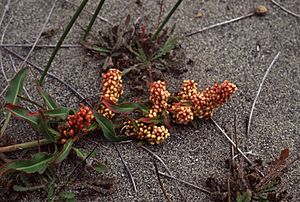Willow dock facts for kids
Quick facts for kids Willow dock |
|
|---|---|
 |
|
| In fruit | |
| Scientific classification | |
| Genus: |
Rumex
|
| Species: |
salicifolius
|
Rumex salicifolius, also known as willow dock or willow-leaved dock, is a type of flowering plant. It belongs to the knotweed family. This plant is a perennial, which means it lives for more than two years.
Willow dock is originally from western North America, especially in California, Arizona, and Nevada. It can also be found in parts of Europe, where it was brought by people and now grows along roadsides. This plant can look quite different from one place to another.
Contents
What Does Willow Dock Look Like?
The willow dock plant is a herb that grows from a slender stem. This stem can lie flat on the ground, spread out, or stand upright, reaching up to about 90 centimeters (about 3 feet) long.
Its leaves can be up to 13 centimeters (about 5 inches) long and come in many different shapes. The plant's flowers grow in groups called an inflorescence. These groups are spaced out along the stem. Each group can have up to 20 small flowers, and each flower hangs from a tiny stalk called a pedicel.
Each flower usually has six parts called tepals. The three inner tepals are bigger and often have small bumps in the middle. Willow dock plants are usually green, sometimes with hints of pink and red.
This plant is very important for the larvae (young caterpillars) of the Lycaena rubidus butterfly, as it is a key food source for them.
Where Does Willow Dock Grow?
You can find Rumex salicifolius in different parts of California, as well as in Arizona, Nevada, and northern Mexico. More recently, it has started growing in parts of Europe, where it was introduced by people.
Willow Dock's Home
Willow dock usually grows in wet areas, but not in places that are completely flooded. It likes areas next to wetlands that get wet at certain times of the year. You might also find these plants on rocky slopes or at the edges of other plant groups.
It typically grows at altitudes lower than 3,500 meters (about 11,500 feet). The plant usually blooms, or flowers, from June through September. It grows best in full sunlight but can sometimes grow in partial shade too.
How Scientists Classify Willow Dock
Rumex salicifolius is a dicot, which means its seeds have two "embryonic leaves" or cotyledons when they first sprout.
Here's how scientists classify it:
- Kingdom: Plantae (Plants)
- Order: Caryophyllales
- Family: Polygonaceae (the buckwheat or knotweed family)
- Genus: Rumex (which includes many types of docks)
Scientists have identified many different types of Rumex salicifolius, which they call subspecies or varieties. This shows how much the plant can change depending on where it grows.

